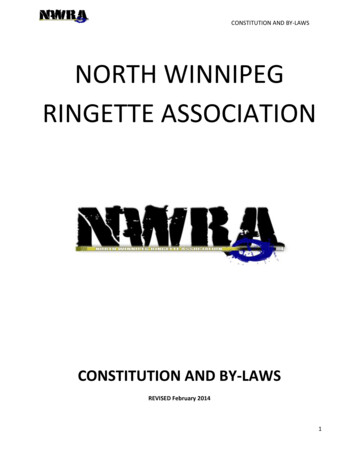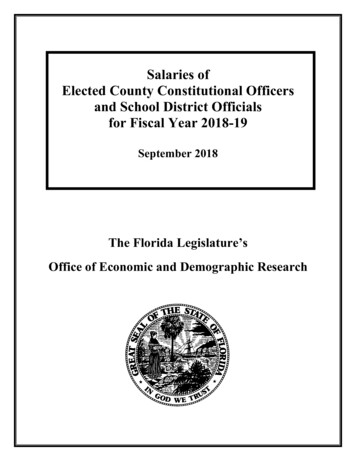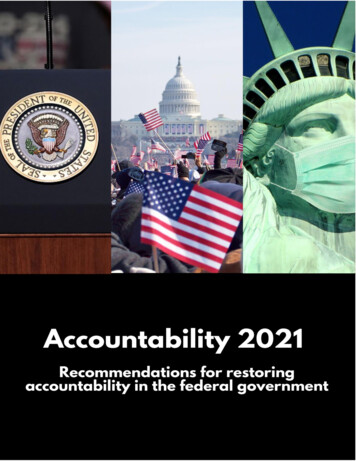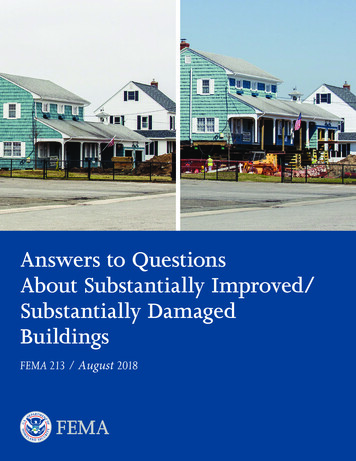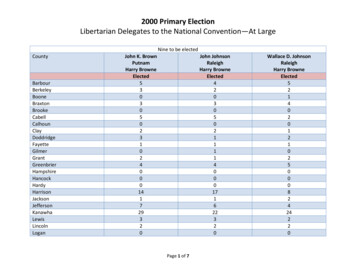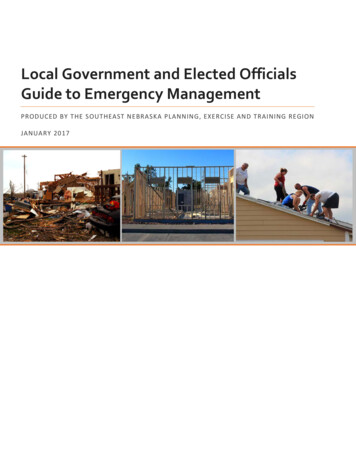
Transcription
Local Government and Elected OfficialsGuide to Emergency ManagementPRODUCED BY THE SOUTHEAST NEBRASKA PLANNING, EXERCISE AND TRAINING REGIONJANUARY 2017
ContentsI. ACRONYMS .3II. OVERVIEW . 4III. ROLE OF ELECTED OFFICIALS IN EMERGENCY MANAGEMENT .5A. ROLE OF ELECTED OFFICIALS BEFORE A DISASTER OCCURS .5B. ROLE OF ELECTED OFFICIALS DURING A DISASTER. 6C. ROLE OF ELECTED OFFICIALS FOLLOWING A DISASTER . 6D. NIMS and ICS . 7IV. MANAGING EMERGENCIES. 8A. Emergency Operations Center (EOC) OPERATIONS . 8B. Declaring a Local Disaster.10C. State of Emergency Proclamation . 11D. Federal Disaster Assistance/Declaration . 11V. LAWS AND AUTHORITIES . 13VI. RESOURCE LINKS .14Attachment 1 – SAMPLE LOCAL DISASTER DECLARATION . 15Photos courtesy of Jodi Fawl, Nebraska Emergency Management Agency and Barb Sturner, Federal EmergencyManagement Agency Region VII.Page 2 of 15
I. ACRONYMSCOG - Continuity of GovernmentCOOP - Continuity of Operations PlanEMA - Emergency Management AgencyEMS - Emergency Medical ServicesEOC - Emergency Operations CenterESF - Emergency Support FunctionFEMA - Federal Emergency Management AgencyIC - Incident CommanderICS - Incident Command SystemIS - Independent StudyLEOP - Local Emergency Operations PlanNEMA - Nebraska Emergency Management AgencyNGO - Non Government OrganizationNIMS - National Incident Management SystemPDA - Preliminary Damage AssessmentPage 3 of 15
II. OVERVIEWThe State of Nebraska is vulnerable to many hazards,ranging from severe storms and flooding, to terrorism andnuclear power plant incidents. Locally-elected officials areresponsible for ensuring the public safety and welfare oftheir communities.The duties of responding to and recovering from incidents,begin and end at the local level with public officials andcommunity members. Emergency management operationsbefore, during, and after an emergency or disaster, are anessential function of local elected officials and localgovernment agencies.This Guide is a resource to assist Local Government Officials to better understand their roles andresponsibilities related to preparing for, responding to, recovering from and mitigating all hazards that mayoccur in their jurisdiction.Citizens expect their government to protect them, assist them, and inform them when a disaster threatens oroccurs, and to instruct them when it is necessary to take protective actions for their own personal safety.Educating the public and working directly with the citizens and the media is imperative for a successfulemergency management program.This guide is meant to be a general overview of the Emergency Management process for local governmentand elected officials, and is not a complete reference document. Please consult your local EmergencyManagement Director for further information or questions.Related Publications and Disaster related documents referenced in this document can be found in the“Resource Links” section of this guide.Page 4 of 15
III. ROLE OF ELECTED OFFICIALS IN EMERGENCY MANAGEMENTAll disasters are locally-driven events, and it is the local official’s role to provide leadership and policyguidance to their jurisdiction before, during, and after a disaster.It is important for local elected officials to engage in preparedness efforts, which are ongoing and involveactivities undertaken to prepare for disasters and emergencies, as well as to facilitate future response andrecovery efforts.The following sections detail some of the local official’s roles and responsibilities before, during, andfollowing a disaster:A. ROLE OF ELECTED OFFICIALS BEFORE A DISASTER OCCURSThe primary role of an elected official before a disaster is that of preparedness. Whether you are aCommissioner or a Councilmember, you have the ability to guide your City towards effective emergencymanagement planning strategies. Many give in to the notion that emergency preparedness is too daunting,so why try. But it is the citizen’s expectation of you to always keep emergency management in your list ofpriorities when you serve, especially during budget preparation. The following is a list of suggestions to followto help you be as prepared as you can possibly be. Make planning for emergencies and disasters a priority at all levels of your organization.Meet with your Local Emergency Management Agency to learn about the hazards that threaten yourjurisdiction and what is being done to address those hazards.Learn about emergency management and disaster assistance programs both at the state and federallevels, (These Resources can be found in the Resource Links Section)Provide policy direction for prevention/protection-related, response, recovery, and mitigation-relatedactivities,Encourage all government agencies and business leaders to coordinate and collaborate with yourjurisdiction’s Emergency Management Agency.Ensure your Continuity of Operations (COOP) and Continuity of Government (COG) plans are up-todate.Provide policy direction for emergency management-related activities, when needed.Familiarize yourself with your jurisdiction’s Emergency Operations Center (EOC).Encourage individuals, families, and businesses in your community to develop an emergency plan andbe self-sufficient in the immediate aftermath of a disaster.Obtain the necessary training to become a leader to your constituents during an emergency.Participate in emergency and disaster drills and exercises.Learn the damage assessment process and how it impacts the possibility of obtaining federalassistance.Learn your legal authorities and responsibilities.Page 5 of 15
B. ROLE OF ELECTED OFFICIALS DURING A DISASTERThe primary role of an elected official during a disaster is that of support. As the disaster is occurring and theimmediate response is underway, you will best serve your citizens by empowering and allowing your firstresponders and the EOC staff the freedom to manage the incident as they have been trained to do. Allowthem time to stabilize the situation before attempting to step in as a decision maker. Your role as decisionmaker will come, but the primary goal of addressing a disaster as it is happening is to stabilize the situationquickly and efficiently – your staff will do that for you. To help in this goal, your role consists of: Support and work with your emergency management officials, as needed. This may includefacilitating communication with and obtaining assistance from other agencies, declaring a local stateof emergency, and issuing emergency orders.Communicate quickly, clearly, and effectively to your constituents and work with your partners toensure a coordinated message.Get accurate information out early and often, and ensure all messaging is accessible.Maintain situational awareness regarding the disaster by staying informed.Provide direction for response-related activities, whenappropriate.Trust and empower your emergency managementofficials to make the right decisions.Serve your citizens by allowing the First Respondersand the EOC staff to manage the incident as they aretrained to do. The active participation of ElectedOfficials in planning / training before a disaster andleadership during the recovery period is where you willhave the greatest impact and be of most value.Use an EOC Liaison to help you stay informed duringthe incident.C. ROLE OF ELECTED OFFICIALS FOLLOWING A DISASTERThe primary role of an elected official after a disaster is that of leadership. Once the first responders and EOCstaff have stabilized the situation, your role as an elected official becomes crucial to the recovery process. Acommunity is built on law and order, and this stems from City Code, Zoning Regulations, Building Code,Police Enforcement, and much more. Just because a disaster occurs does not mean these regulations are nulland void. On the contrary, they are crucial to make sure your community is built back right. For a City to trulyrecover, diligent and firm adherence to the City’s Codes and Regulations must be adhered to. To help inaccomplishing this goal, the following is a list of roles for you to fill. Understand the disaster assistance programs available and application process for State of Nebraskaand the Federal Disaster Declarations.Support your community throughout the recovery – it can be a long process and may take multipleyears.The State of Nebraska views recovery in terms of short – (days to weeks), intermediate – (weeks tomonths), and long-term recovery (months to years).Page 6 of 15
Help identify opportunities to rebuild and mitigate future damage through planning and smartinfrastructure investments.Ask questions – the recovery process and programs can be complex.Ensure all Codes and Regulations are enforced during the recovery process.D. NIMS and ICSThe National Incident Management System (NIMS) is applicable to state, tribal and local governments,private sector organizations, critical infrastructure owners and operators, nongovernmental organizationsand other organizations with an active role in emergency management and incident response. State andLocal Governments must comply with the use of NIMS and ICS to remain eligible to receive federal HomelandSecurity or Federal Emergency Management Agency grant funding – this is often referred to as being NIMSCompliant.Local First Responders use NIMS and the Incident Command System (ICS) on every call. Elected andappointed officials, who are responsible for jurisdictional policy decisions, must also have a clearunderstanding of Incident Command and NIMS, and their roles and responsibilities in the ICS process. Thebasic NIMS/ICS on-line classes listed below are vital for local government workers and Elected Officials.A basic premise of NIMS is that all incidents begin and end locally. NIMS does not take command away fromstate and local authorities. NIMS simply provides the framework to enhance the ability of responders,including the private sector and NGOs, to work together more effectively.ICS is a widely applicable management system designed to enable effective, efficient incident managementby integrating a combination of facilities, equipment, personnel, procedures and communications operatingwithin a common organizational structure.The minimum training requirements for NIMS is the completion of the Basic IncidentCommand System (IS-100) and NIMS an Introduction (IS-700). These are free on-line courses available on theFEMA Website. See the resource links page for a link to the FEMA Emergency Management Institute foraccess to the NIMS/ICS Independent Study (IS) courses.Page 7 of 15
IV. MANAGING EMERGENCIESThe Chief Executive Officer, whether Mayor, County/CityCommissioner, Chair of the Village Board or other title,bears the direct and ultimate responsibility for how well thejurisdiction prevents, prepares for, survives and recoversfrom an emergency or disaster.The Emergency Manager provides assistance and advisesthe Chief Executive Officer to ensure that proper emergencyactions are taken in a timely manner to provide the care andsupport for those citizens affected.A. Emergency Operations Center (EOC)OPERATIONSEOCs are used to help coordinate and manage disasters that require response resources from numerousagencies and/or levels of government. An EOC is a location from which centralized emergency managementcan be performed. It is a facility used to coordinate the overall agency or jurisdictional response and supportto an emergency.The EOC exists to support the response activities occurring in the field, and it is critical that all informationand/or resource requests be routed through the EOC when activated. EOCs are typically activated forlarger events, or in some cases to monitor emerging situations or planned events. EOCs vary in size andcomplexity depending upon the jurisdiction.Elected officials should make time to visit their jurisdiction’s EOC to understand how it is organized andactivated during an event. Please remember, during a disaster you as an elected official will need to report toyour City’s designated center of operations, not the EOC unless requested.Page 8 of 15
Figure 1. Sample EOC Organization Chart (ICS-207)It is important for all elected officials and local government department heads to understand their role in theprocess and where they fit into the incident organization.In Figure 1 (ICS-207), Mayors and Commissioners fall into the Policy Group. Other officials (Assessors, Clerks,Treasurers and Administrators) may be assigned to the Finance/Admin or Documentation section as neededto manage the incident.Page 9 of 15
Policy Group functions in support of the EOC: Support the EOC Manager in providing jurisdictional coordination amongst all governmentdepartments. Make policy and financial decisions related to the emergency or disaster. Make strategic decisions as needed or requested by the emergency manager and/or theIncident Commander. Determine jurisdictional priorities to ensure they are included in the long-term incident planning. Provide legal guidance to the incident and EOC managers. Consider cultural, economic, political and social implications of the incident and communicate needs to theincident and EOC managers. Request that a Liaison Officer position be established between the EOC and the Policy Group to helpcoordinate the flow of information and interactions between these two elements. Create Delegations of Authority (also known as Delegations of Responsibility), Declarations ofEmergency/Disaster, and any other documents needed to ensure the safety of the population and theability for the community to recover.B. Declaring a Local DisasterMost emergencies are handled locally without any need for State or Federal assistance. However, in thosecases where the emergency evolves into a disaster that overwhelms Local or State resources, there is anestablished process to seek support from the Federal government.Local authorities are the first line of response in disasters. Bystate statute, the Chief Elected Official of the jurisdiction ischarged with taking immediate steps to warn and evacuatecitizens, alleviate suffering, and protect life and property. Inaddition, local authorities are responsible for conducting theinitial damage assessment and notifying the appropriate Stateagencies.The advice is to declare a local disaster in any situation that may have a significant impact socially oreconomically on the citizens within your jurisdiction when the situations threatens to exhaust or over-whelmlocal resources (personnel, equipment, materials, money, etc.). Note that any protective action that mayrequire the evacuation of residents with special needs, such as day care/school age children, elderly residents,people with mobility problems, hospitalized or institutionalized populations, should be considered as areason for a local disaster declaration.Declaring a disaster appropriately will . increase coverage related to liability for the jurisdiction; an important resource for legal considerationswill be the city or county attorney make it easier to utilize mutual aid agreements to obtain resources and personnel from nearby localjurisdictionsPage 10 of 15
mobilize additional powers under the Nebraska Emergency Management Act; e.g., State and Federalassistance which would otherwise be unavailable without a local declarationProvisions for a declaration are covered in the Local Emergency Operations Plan (LEOP). The local disasterdeclaration must be signed by the Chief village, City or County Elected Official, or their designee, incoordination with the local Emergency Manager.1 Prompt notification by the Emergency Manager, of a localor county disaster declaration must be made to NEMA, who in turn reviews it and may submit it to the StateAdjutant General. When warranted, the disaster declaration is forwarded to the Governor’s office.Should the disaster affect other counties or have a scope that State resources are required, the Governor mayissue a State Emergency Declaration.The declaration of a local or county emergency does not guarantee the availability of financial support by theGovernor’s Emergency Fund. To qualify for Emergency Fund support the jurisdiction must meet the damageexpense thresholds as defined in the “Governor’s Emergency Fund – Guidance for Local Officials”Consult with the Public Information Officer to effectively disseminate timely information to the public andmedia outlets when a disaster declaration is made.C. State of Emergency ProclamationUpon the advice of NEMA, the Governor may sign a State of Emergency Proclamation. The justification for aproclamation is based on the information about damages reported to NEMA by local officials, as well as theapparent need for additional resources to protect lives and property. When the Governor issues a State ofEmergency Proclamation, the Governor's Emergency Fund is activated and all State resources becomeavailable to assist local jurisdictions. A State Proclamation provides the Governor with emergency powersnecessary to deal with a disaster. NEMA provides the coordination between supporting agencies and criticalor key resources.D. Federal Disaster Assistance/DeclarationA request for Federal assistance from the Federal Emergency Management Agency may be made after theGovernor declares a State of Emergency and issues a request for a joint State and Federal (with the assistanceof Region VII FEMA) Preliminary Damage Assessment (PDA).NEMA RecoveryDepending on the scope of the disaster, two different sets of damageSection Managerassessment teams could be deployed to the field comprised of Local,(402) 471-7416State, and Federal representatives. One team assesses the damage toprivately owned structures and small businesses. The second team istasked with assessing damage to public facilities. Information collectedthrough the Preliminary Disaster Assessments (PDAs) [see the LEOP Annex C, Damage Assessment], willaffect the authorization of a Federal Disaster Declaration. For assistance or guidance on this procedure,Emergency Managers contact the NEMA Recovery Division Manager at (402) 471-7416.1A template for a declaring a local disaster is included as an appendix to this guide.Page 11 of 15
Some specific Federal assistance may be available to the State of Nebraska without a Federal DisasterDeclaration. Typically, this support comes either from the U.S. Small Business Administration (SBA) or theU.S. Department of Agriculture. For this reason, it is vital that Emergency Managers keep NEMA appraised ofthe situation as it develops.If the President declares a disaster, Federal assistance becomes available to affected communities throughthe Stafford Disaster Relief and Emergency Assistance Act. FEMA implements the provisions of this Act.Throughout this process local officials remain in charge of their jurisdiction. Depending on the magnitude ofthe disaster, Emergency Managers will be required to provide assistance to State and Federal representativesdeployed to their community. If a Federal Disaster Declaration is not issued, or Federal assistance is denied,the cost of response and recovery efforts may still qualify for State Disaster Assistance (Public Sector only) ormay have to be borne by the citizens of the affected jurisdiction.Page 12 of 15
V. LAWS AND AUTHORITIESThe powers and duties of local officials are set forth in State statutes, and modified by home rule. When alocal government wants to do something not authorized by these statutes or by the constitution, it must askthe legislature for a law permitting it to undertake the new activity.Many activities of local officials, particularly County officials, are concerned with what might be consideredState rather than County activities. The State itself generally depends on County officials for the enforcementof State laws.Effective July 19, 1996, the Nebraska Emergency Management Act (Reissue Revised Statutes of Nebraska,Section 81-829.31 and Sections 81-829.36 to 81-829.75) became law, establishing standards and guidance forEmergency Management operations in Nebraska. The Nebraska Emergency Management Act addresses allareas of emergency management including the roles and responsibilities of State and Local officials, theGovernor’s Emergency Fund, emergency management aid and assistance, mutual aid, and liability issues.There are two provisions of the Nebraska Emergency Management Act that Local Elected Officials shouldbecome familiar with: RRS Section 81-829.50 (1): A local emergency may be declared only by the principal executive officerof a local government who finds that conditions defined as a disaster or an emergency exist or by aperson who by resolution has been authorized and designated by the governing board of a localgovernment to determine that an emergency within the scope of his or her authorization exists. Acopy of the resolution shall be filed with the Nebraska Emergency Management Agency to beeffective. The proclamation shall continue in effect until the principle executive officer finds that thoseconditions no longer exist. Robert T. Stafford Disaster Relief and Emergency Assistance Act, PL 100-707, signed into lawNovember 23, 1988; amended the Disaster Relief Act of 1974, PL 93-288. This Act constitutes thestatutory authority for most Federal disaster response activities especially as they pertain to FEMAand FEMA programs.Page 13 of 15
VI. RESOURCE LINKSFederal Emergency Management Agencywww.fema.govFEMA Emergency Management Institute (NIMS/ICS Training)https://training.fema.gov/is/Nebraska Emergency Management Agencywww.nema.ne.govNebraska Governor's Emergency Fund ernors-emergency-fundNebraska Local Emergency Operations braska State Emergency Operations mergency-operations-planNebraska Radiological Emergency Response ical-emergency-preparedness-rep-linksNebraska State Hazard Mitigation d-mitigation-programNebraska Emergency Management Additional Links, Publications and Disaster Related Documents can be found atwww.nema.nebraska.gov/news/newsroom-indexPage 14 of 15
Attachment 1 – SAMPLE LOCAL DISASTER DECLARATION A Disaster Declaration must be issued prior to requesting state or federal assistance.A Disaster Declaration for a city or village should be transmitted through the County Emergency ManagementDirector.The County Board should also declare a disaster using this same form. The following is a sample of the languagethat should be retyped onto the jurisdiction’s official letterhead before submitting it to the State EmergencyOperations Center (EOC)*** County (or affected city/village) has suffered from a (i.e., disastrous tornado strike) that occurredon (include date(s) and time) causing severe damage to public and private property, disruption ofutility service, and endangerment of health and safety of the citizens of *** County (or city/village) within thedisaster area.Therefore, the Chair of the *** County Board of Commissioners/Supervisors (or theMayor/Board Chair of ) has declared a state of emergency authorized underNebraska State Statute R.R.S. 81-829.50 on behalf of *** County (or city/village), and will execute for and onbehalf of *** County (or city/village), the expenditure of emergency funds from all available sources, theinvoking of mutual aid agreements, and the applying to the State of Nebraska for assistance from the Governor'sEmergency Fund and any other resources he/she deems necessary in the fulfillment of his/her duties.WITNESS my hand and the seal of my office Chair, *** County thisday of , 20 .Board of Commissioners/Supervisors(or Mayor/Board Chair of affected jurisdiction or by appointed authorized representative)County (or City/Village) ClerkDatePage 15 of 15
The National Incident Management System ( NIMS) is applicable to state, tribal and local governments, private sector organizations, critical infrastructure owners and operators, nongovernmental organizations and other organizations with an active role in eme rgency management and incident response. State and


